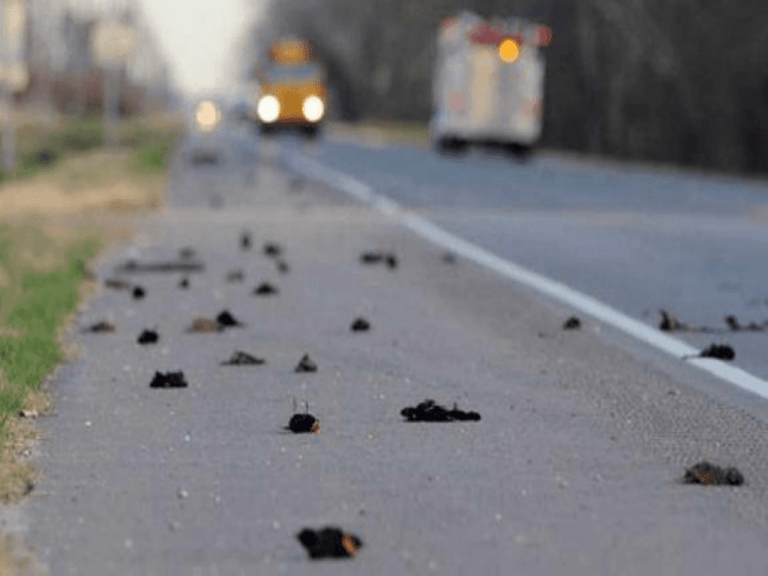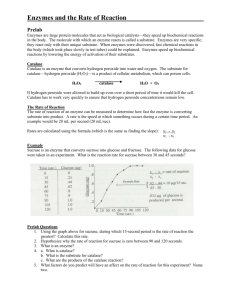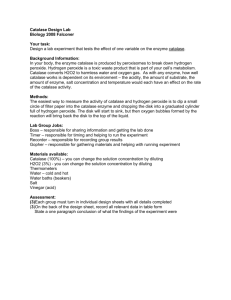Concentration and Reaction Rate
advertisement

Birds & Aging • Many birds appear not to show the effects of cellular senescence (i.e. cells stop reproducing) • This failure to show the physical effects of aging may be due to high levels of peroxidases Peroxides • Highly reactive, strong oxidizers • When broken down slowly, may produce FREE RADICALS, which can damage DNA and other cellular structures • While some free radicals may help the immune system, others may lead to oxidative stress Peroxidases • Enzymes that reduce the activation energy required to cause the decomposition of peroxides • Rapid breakdown = fewer free radicals Catalase • Found in most forms of life on Earth • One molecule of catalase can convert 40 million hydrogen peroxide molecules/sec • 500 amino acid long protein, containing four heme (iron) rings held together in the quaternary structure • Iron in heme rings reacts to pull electrons away from H2O2 bonds, causing it to disassociate LAB: Decomposition of Hydrogen Peroxide via Catalase • Purpose: To assess the effects of enzyme concentration, ambient temperature and pH on the rate of decomposition of hydrogen peroxide • Method: Measure rate of pressure change (kPa/sec) Concentration and Reaction Rate • Because the relationship between substrate and enzyme is so specific, changing the number of enzymes reacting with the substrate (or vice versa) may affect the rate of reaction • Ex: Vmax Temperature and Reaction Rate • Temperature is a measurement of molecular speed • At a lower temperature, molecules collide less frequently • At higher temperatures molecules collide more frequently • Enzymes tend to have an optimal temperature at which they function pH and Reaction Rate • Enzymes have specific pH ranges in which they tend to function most effectively • Outside of this range, enzymes can denature, causing them not to fit with their substrates • If enzyme does not fit, EA is too large for the reaction to occur GROUPS & VARIABLES • GROUPS 1 & 4 – Concentration • GROUPS 2 & 5 – Temperature • GROUPS 3 & 6 – pH • Dependent Variable For All = slope (m) for plot of pressure v. time Lab Notes • Take 20 mL of catalase suspension to your table in beaker. • Use different seral pipettes to dispense H2O2 and catalase suspensions • Total volume in test tubes will be 7mL • pH ranges tested will be 3,5,9 & 11. Change data tables to reflect this alteration. • Post and average the class data Part 1 Protocol • Clean and dry the large test tubes • If you are doing part 1 (concentration) add (in this order… – 3mL water – 1 to 4 mL of Catalase enzyme suspension – 3mL H2O2 Immediately cap the tube and collect the data Part 2 Protocol • Clean and dry the large test tubes • Place test tube into 0-5°C ice bath • Add (in this order)… – 3mL water – 1 mL of Catalase enzyme suspension – 3mL H2O2 Immediately cap the tube and collect the data Repeat steps at room temperature, 30-35 °C and 50-55°C Part 3 Protocol • Clean and dry the large test tubes • Add (in this order)… – 3mL pH 3 solution – 1 mL of Catalase enzyme suspension – 3mL H2O2 Immediately cap the tube and collect the data Repeat steps using 3mL of pH 5, 9 and 11







